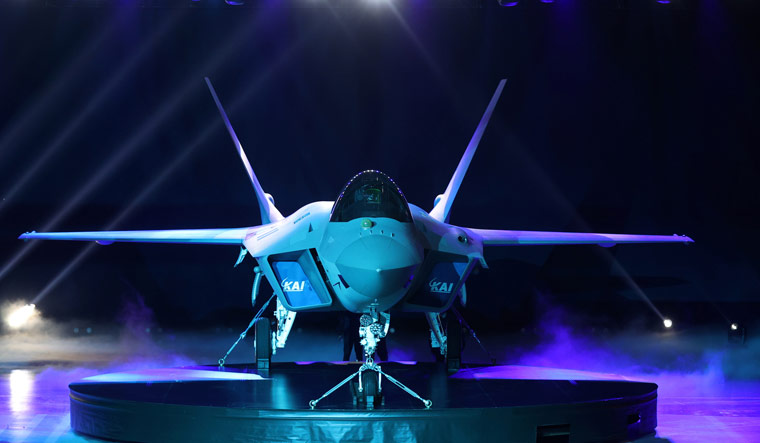South Korea on Friday unveiled the prototype of its new '4.5 generation' fighter dubbed the KF-21 Boramae (young hawk trained for hunting), nearly 20 years after the project to build it was announced.
A fighter of the 4.5 generation is classified as having high manoeuvrability, advanced weapons for air-to-air and air-to-surface missions, features to reduce radar signature and integration of radar and infra-red sensors. A 4.5 generation fighter carries its weapons on external hardpoints on the wings and fuselage, unlike 5th generation aircraft that have internal weapons bays to increase stealth.
South Korean President Moon Jae-in and Indonesian Defence Minister Prabowo Subianto were among the key participants at the launch of the fighter.
In 2001, then South Korean president Kim Dae Jung had pledged to develop an indigenous fighter for the country by 2015 to replace its fleet of F-4 and F-5 aircraft.
In 2019, reports emerged Indonesia was backtracking on its commitments to the KF-21 project. Indonesia had agreed to provide $1.3 billion to buy 48 aircraft and also secure transfer of technology for it. However, Indonesia has provided only around $202 million so far, Yonhap reported. South Korea and Indonesia are continuing talks on the project.
History of KF-21
The formal development of the KF-21 fighter began in late 2015. According to South Korea's Yonhap news agency, the country had allocated $7.9 billion to develop and build 120 KF-21 fighters.
The KF-21, a twin-engine aircraft, is capable of carrying up to 7.7 tonnes of weapons and fuel under its wings and fuselage.
The first flight of the KF-21 is expected to be completed in 2022. The KF-21 resembles the US F-35 stealth fighter outwardly. South Korea is a user of the F-35, and the KF-21 has been touted as a “cheaper, less-stealthy alternative” to the US jet.
The current variant of the KF-21 does not feature an internal weapons bay, but future variants could have it. "Based on this 4.5 generation platform, South Korea will be capable of building more advanced versions down the road," professor Bang Hyo-Choong of the Korea Advanced Institute of Science and Technology (KAIST) told Yonhap.
South Korea is purchasing air-to-air missiles for the first KF-21 batch from European companies MBDA and Diehl BGT.
South Korea has adopted a phased development approach to building the KF-21. "The KF-X Block I will not have an internal weapons carriage, which is planned for subsequent production blocks. The initial version will also lack air-to-ground striking capability since the home-grown long-range air-to-ground missile is to be developed by the mid-2020s," Defense News reported in 2019. Israeli company Elbit is assisting in the development of the radar of the KF-21.
KF-21 and AMCA
The KF-21 will be powered by two F414 engines, built by US company GE. GE delivered the first F414 engines to South Korea last year. Interestingly, the F414 will also power the initial variants of India's under-development Advanced Medium Combat Aircraft (AMCA) stealth fighter. The DRDO currently plans to fly the first prototype of the AMCA by 2025.
also read
- Major US arms deliveries to Indian Air Force you should know about! C-130 Hercules, C-17 Globemaster and more!
- IAF commanders to discuss ‘Gagan Shakti’ lessons in apex four-day meet
- How induction of 56 C-295 military aircraft will make Indian Air Force more deadly and agile
- IN PICS | Chennai IAF airshow: How bad was the crowd, traffic at Marina Beach as 5 dead, Velachery railway station crowded?
- Chennai IAF airshow: What happened at Marina beach as 5 dead, Velachery railway station crowded?
The AMCA will be similar to the KF-21 in being a twin-engine fighter with an approximate take-off weight of around 25 tonnes.
While similar in layout to the KF-21, the AMCA is being designed with an internal weapons bay. The DRDO has also hinted at developing an unmanned version of the AMCA. In February this year, A.K. Ghosh, the director of the AMCA project for DRDO, told The New Indian Express, "We have plans in future to incorporate 6th generation technologies, where it will be possible to fly AMCA aircraft in an autonomous mode for dangerous missions.”
The Indian Air Force currently expects to buy up to 125 AMCA fighters. According to reports, the first two squadrons of AMCA jets would be powered by the F414 engines, while the remaining ones would be equipped with a higher-thrust engine to be developed in India with foreign assistance.











